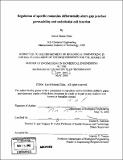Regulation of specific connexins differentially alters gap junction permeability and endothelial cell function
Author(s)
Elihu, David Morad
DownloadFull printable version (14.73Mb)
Other Contributors
Massachusetts Institute of Technology. Biological Engineering Division.
Advisor
Elazer R. Edelman.
Terms of use
Metadata
Show full item recordAbstract
While many have explored how vascular processes alter gap junction communication and composition few have analyzed the role of specific gap junction connexin proteins in regulating cellular communication and wound healing. Using RNA interference or peptide inhibitors to downregulate specific connexins we examined the role of gap junctions in intercellular diffusion, calcium excitation, and in mediating the expression of vascular regulators transforming growth factor-[Beta][ (TGF-[beta]), prostacyclin, and endothelial nitric oxide synthase (eNOS). siRNA inhibition of connexin 43 in porcine aortic endothelial cells (PAEC) significantly decreased the diffusion distance of Lucifer yellow dye and cytoplasmic calcium levels after mechanical wounding. Wound healing experiments suggested that stimulatory signals travel through gap junctions containing connexin 43, while inhibitory signal travel through gap junctions containing connexin 37. Connexin 43 and connexin 37 inhibition, alone or in combination, reduced the levels of secreted latent TGF-[beta] in confluent PAEC monolayers after 24 hours of incubation. Human umbilical vein endothelial cells (HUVEC) behaved in a similar manner. Inhibition of any one of the three connexins resulted in a marked increase in eNOS concentration. (cont.) Yet, TGF-P was sensitive to simultaneous inhibition of connexins 37, 40, and 43 and prostacyclin was controlled by connexin 37 and/or connexin 40 but not connexin 43. We have demonstrated how selective inhibition of gap junction connexin expression can reveal the potent gap junction mediation of cellular communication, wound healing, and vascular function. We demonstrate for the first time that connexin proteins play distinct roles in vasoregulation with differential effects on TGF- [beta], eNOS and prostacyclin. This technique in general and findings in specific may help explain density-dependent control of vascular signaling and repair.
Description
Thesis (M. Eng.)--Massachusetts Institute of Technology, Biological Engineering Division, 2006. Includes bibliographical references (leaves 80-84).
Date issued
2006Department
Massachusetts Institute of Technology. Department of Biological EngineeringPublisher
Massachusetts Institute of Technology
Keywords
Biological Engineering Division.